Though gaining a detailed understanding of the effects
episodic encounters with comets had on humanity will take some
time, incorporating recent astronomical evidence can provide
immediate boons to our comprehension of past cultures. This is
particularly true for certain symbols and motifs that have
endured to our time period. Wilson's 1894 work on the history of
the swastika is quite valuable in showing how widely that symbol
was utilized and what meanings came to be associated with it.
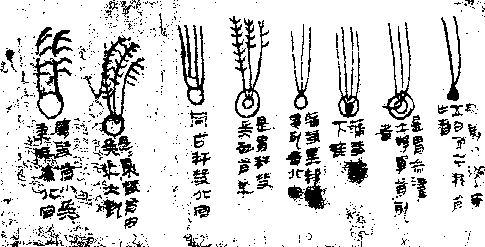
|
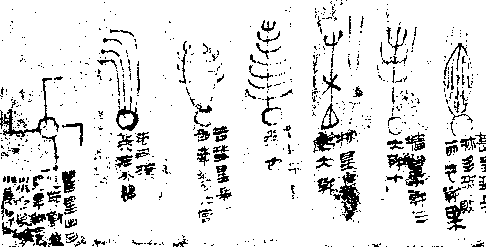
|
| The fortunate find in the seventies,
at Mawangdui, China, of a Han dynasty silk comet atlas
sheds considerable light on earlier enigmatic motifs.
Most illuminating is the drawing, described by text on
the artifact as a long-tailed pheasant star. This
rendering of a jetting comet viewed down its axis of
rotation has a considerable history, and, as a motif,
appears on artifacts found in most areas of the world.
The artist who illustrated this silk twenty-two hundred,
or so, years ago was not likely a first-hand observer.
What is produced here is a schematic of received comet
caricatures with claims that specific things will happen
if a represented type appears. The pinwheel-like image
is unique to the compilation in that an omen is given for
an appearance in each of the four seasons, implying that
this comet was seen more often than the others
represented. This may illustrate a frequently viewed
aspect of comet Encke which has a 3.3 year orbit and
rotational axis that occasionally points toward Earth.
[Whipple, F. 1985] |
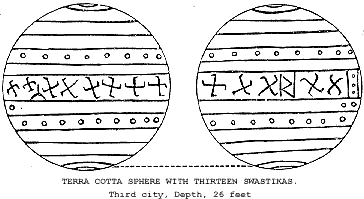 |
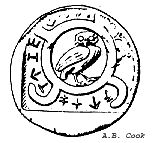 |
Important in understanding ancient oriental lore is
learning that this motif was associated with the pheasant
(divine bird in China) which is frequently mentioned in
the Chinese classics. The link between the spinning cross
and birds is evident on artifacts from many cultures.
Perhaps the association of the Sanskrit term
"svastika" with this symbol can be linked to
the Astika Parva in the MAHABHARATA
which relates the birth of a cosmic bird par excellence--Garuda. This
fabulous winged deity had a radiance like the Sun, could
change shapes at will, and destroyed other gods and kings
by casting down fire and stirring up storms of reddish
dust which darkened the Sun, Moon and stars. Clearly
Garuda was symbolic of an Earth approaching comet. |
The bird-comet connection is even more obvious in the
Jamva-khanda Nirmana Parva of the MAHABHARATA which describes a
fierce fowl with but one wing, one eye, and one leg, hovering in
the night sky. As this bird "screams" and "vomits
blood":
All the quarters of the earth, being overwhelmed by
showers of dust, look inauspicious. Fierce clouds, portentous
of danger, drop bloody showers during the night. Rahu of
fierce deeds is also, O monarch, afflicting the constellation
Kirtika. Rough winds, portending fierce danger, are
constantly blowing.
The mention of Rahu, the demon of eclipse, which originally
had four arms and a tail that was severed by Vishnu to become
Ketu (comet) is interesting in that the demon is here darkening
Kirttika (the Pleiades) in the month of Karttika (latter half of
October, through mid November), for the tale goes on to relate
that:
. . . in course of the same month both the Moon and the
Sun have undergone eclipses on the thirteenth days from the
day of the first lunation. The Sun and the Moon therefore, by
undergoing eclipses on unusual days, will cause a great
slaughter of the creatures of the earth. Meteors,
effulgent like Indra's thunder-bolt, fall with loud hisses .
. . People, for meeting together, coming out of their houses
with lighted brands, have still to encounter a thick gloom
all round . . . From the mountains of Kailasa and Mandara and
Himavat thousands of explosions are heard and thousands
of summits are tumbling down . . . Fierce winds charged with
pointed pebbles are blowing, crushing mighty trees. In
villages and towns trees, ordinary and sacred, are falling
down, crushed by mighty winds and struck by lightning.
This is, without doubt, a mythological record of an intense
meteor storm from the still active Taurid stream which presently
peaks around the first of November and appears to radiate from
near the Pleiades star cluster. The un-airworthy bird associated
with this meteor bombardment could have been comet Encke which
until recently was thought to be the sole source for the Taurid
meteors. However, the discovery of other large contributors which
are now dark but were once active comets rules out a positive
identification.
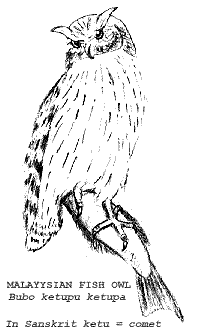 |
Another interesting aspect of this folk memory which
might shed some light on why the rolling cross motif is
linked to birds is the image of a one-legged fowl. This
is also a characteristic of the Chinese divine pheasant
which was closely associated with the fabulous, lame,
raven-beak-nosed emperor, Yu, who could transform
himself into this pheasant or a bear. One of Yu's
enemies, the Owl, who invented thunder and lightening was
also one-footed. [Lonsdale, S. 1982, Barnard, N. 1972,
1973] |
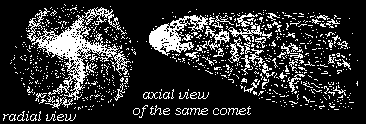
|
In a less artificial environ animal tracks speak strongly
to people and convey much about the creature which left them.
Thus a bear, bird or any animal which made impressions on the
ground could be symbolically represented in total by drawing
these marks. I suggest that the jetting comet, to some cultures,
looked like a bird's foot and, as a
motif, represented a divine fowl. This can explain why the
not very bird-like drawing on the Han silk is captioned as a
pheasant star. Chinese lore upholds such an interpretation as
Ts'ang Chieh, the four eyed legendary inventor of writing,
derived his inspiration to create written symbols from noticing
the marks of birds' feet in the sand. His ancient style is known
as niao chiwen--"bird foot-prints writing."
[MacCulloch, C.J.A. 1928]
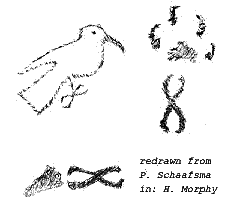 |
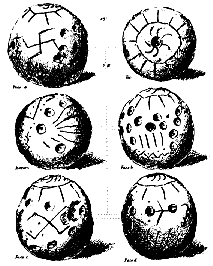 Symbolic bird
tracks, unrecognized as such, appear on objects unearthed
by Heinrich Schliemann from Hissarlik in Asia Minor.
Artifactual support for this contention comes from
petroglyphs found in the south-western United States
which Pueblo people identify as roadrunner (a type of
cuckoo) tracks and identical renderings found by
Schliemann. [Morphy, H. 1989] The close association of
these two distinctive crosses on artifacts from Schliemann's
Troy could be considered coincidental and not
necessarily avion-inspired were they found out of
context, however, in Schliemann's words: Symbolic bird
tracks, unrecognized as such, appear on objects unearthed
by Heinrich Schliemann from Hissarlik in Asia Minor.
Artifactual support for this contention comes from
petroglyphs found in the south-western United States
which Pueblo people identify as roadrunner (a type of
cuckoo) tracks and identical renderings found by
Schliemann. [Morphy, H. 1989] The close association of
these two distinctive crosses on artifacts from Schliemann's
Troy could be considered coincidental and not
necessarily avion-inspired were they found out of
context, however, in Schliemann's words: |
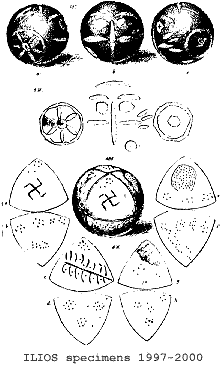 |
 In treating now
of the various kinds of potteryof this third city, I
begin with the owl-faced idols and vases, and I
would repeatedly call very particular attention to
the fact, that the idols, of which I collected about
700, are all of the same shape; that they represent
in the rudest possible outlines a female form; and
that, therefore, they cannot but be copies of the
ancient Palladium, which was fabled to have fallen
from heaven with joined feet. In treating now
of the various kinds of potteryof this third city, I
begin with the owl-faced idols and vases, and I
would repeatedly call very particular attention to
the fact, that the idols, of which I collected about
700, are all of the same shape; that they represent
in the rudest possible outlines a female form; and
that, therefore, they cannot but be copies of the
ancient Palladium, which was fabled to have fallen
from heaven with joined feet.
 From Mari From Mari
|
 |
Owls, like cuckoos, have zygodactylous or
semizygodactylous (outer toe reversible) feet. Obviously
these "Trojans" had an elaborate belief system
which focused on the activities of a non-terrestrial bird
of the night. With this in mind, a re-examination of
artifacts recovered from Hissarlik could be quite
revealing. |
Another aspect of comets which is evident in ancient lore
involves shape shifting. A comet is three dimensional and
could appear as quite a different animal when viewed from a
different angle. For instance, allowing that a foot-print
signifies the creature, the fabled ability of Yu (mentioned above) to transform
into a pheasant or bear can be easily understood as a radial view
distinguished from an axial view of the same comet.
Comets can also change spontaneously; a gas emitting area
could become dust covered and extinguish a jet, a piece of the
comet could break away, creating another comet, perhaps initially
more flamboyant than its parent. Our ancestors' stories speak of
these weakening gods and fantastic births; however, until now,
our ears heard only gibberish.
Comets and the Bronze Age Collapse, from which the
above is excerpted.







 Symbolic bird
tracks, unrecognized as such, appear on objects unearthed
by Heinrich Schliemann from Hissarlik in Asia Minor.
Artifactual support for this contention comes from
petroglyphs found in the south-western United States
which Pueblo people identify as roadrunner (a type of
cuckoo) tracks and identical renderings found by
Schliemann. [Morphy, H. 1989] The close association of
these two distinctive crosses on artifacts from
Symbolic bird
tracks, unrecognized as such, appear on objects unearthed
by Heinrich Schliemann from Hissarlik in Asia Minor.
Artifactual support for this contention comes from
petroglyphs found in the south-western United States
which Pueblo people identify as roadrunner (a type of
cuckoo) tracks and identical renderings found by
Schliemann. [Morphy, H. 1989] The close association of
these two distinctive crosses on artifacts from 

